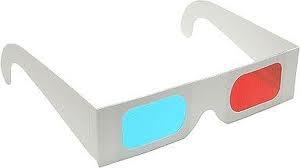To give it it's proper name it's plano- (often known as Stereo 3D or S3D), an idea that's a lot older than television and even older than cinema sound!
experiments began in the 19th century starting with still images but it rapidly followed the movies into the early cinemas. Stereo camera rigs were patented around 1900 and the earliest was shown in the Ambassador Hotel Theatre Los Angeles in September 1922!
Over the past 90 years 3D has come and gone. After each decline there have been various attempts to revive the technology: The 1950's for example, were described as the golden age of 3D with now infamous released in April 1953 with stereo sound!
The 1980s were responsible not just for big hair but for a run of "part III" films ripe for the addition of a "D" at the end of the title. Jaws 3-D, Amityville 3-D and Friday 13th Part III-D, all vying to throw various dismembered body parts over an eager audience!
Each revival was usually the result of a technical advance or technique that seemed to make 3D better or a more compelling but never enough to catch a mass sustainable market.
The ґуПуґ«ГЅ has made 3D content in the past. In 1993 Children in Need made a Doctor Who short using the . ґуПуґ«ГЅ Films made the very successful Streetdance 3D and ґуПуґ«ГЅ Worldwide has begun exploring 3D Natural History programmes. More recently we have tried 3D 6 Nations into cinema and a special Comic Relief Strictly Come Dancing promo.
And! I'm sure you all know showing a mix of sport, movies, and concerts along with a collection of other genres.
Is 3D bad for you?
There has been an incredible amount of hype and misunderstanding about alleged risks from watching 3D. Stereo 3D gives an illusion of depth but your eyes are still focused on the screen plane no matter how far in or out an object actually is. This is where some of the confusion and possible "health scares" come from!
The RNIB has done evaluating the experience partially sighted people have when viewing 3D and an organisation called the International Telecommunications Union (ITU) - part of the UN, has asked the World Health Organisation to report on any effects associated with watching 3DTV.
After watching a lot of 3D television myself what I can say is, well-made 3D is an enjoyable experience, poor 3D can make you feel a bit odd and can give some people headaches but quite frankly you turn poor 3D off long before that!
This site has - I will let you guess which of the four diagrams could cause discomfort!
Some other good links for further reading are;
/rd/publications/whitepaper173.shtml
How do 3D TVs work?

Мэ
Finally here's a very quick overview of different 3D displays and how they work but first we are not doing colour separation 3D or anaglyph!
Anaglyph, Color Code (and other colour variants) work by showing both left and right images at the same time, the left eye image one colour and the right eye image in another.
Мэ
Мэ
Coloured glasses make sure the images go to the appropriate eye.
Мэ

Мэ
Colour performance is very variable as is the 3D effect and it is difficult to focus properly on the image. After the glasses come off the world looks very strange (coloured glasses affect normal colour vision for a while) - Impossible to watch the without the correct version of the coloured glasses
Мэ
Мэ
Мэ
Мэ
Мэ
Polarised Screen

Мэ
Requires a 3D TV with a polarised screen. The left and right eye images are lined up behind the polarising screen, each image is given a different polarisation. To see the 3D image polarised glasses are needed. These are similar to polarised sun glasses but the lens of each eye has a different polarisation to make sure the correct image goes to each eye.

Мэ
Shuttered (above)
Shuttered technology requires two active components - the screen and the glasses. Shuttered LCD glasses are controlled by an infra-red signal sent from the TV. The Left and Right eye images are flashed alternately on the screen at a high frame rate (100 times a second or more). When the Left eye image is on screen the Right eye lens of the glasses is opaque and visi-versa.
At the moment glasses from different manufactures are incompatible so you need to have the right glasses for the TV you have.
3D TV with no glasses
The technology behind 3D TVs that do not need glasses is very similar to the old 3D plastic postcards. It is based on the work done around 1840 by Sir Charles Wheatstone.
The screen is covered with tiny lenses, arranged to send zones of left/right images to the viewer.

Мэ
The lenses direct the left/right images out of the screen in zones. If you sit in a zone at the correct distance you see 3D - if you move out of a zone you lose the 3D image.
Lenticular screen technology is still very new but developing rapidly.
Philips (left) was an early pioneer of this technology for domestic displays.
Мэ
Мэ
I will try and keep you updated between now and the finals weekend if there is news or anything changes but I will give a full explanation of the production as soon as possible after the matches.
Andy Quested is Head of Technology, ґуПуґ«ГЅ HD & 3D, ґуПуґ«ГЅ Future Media & Technology

































